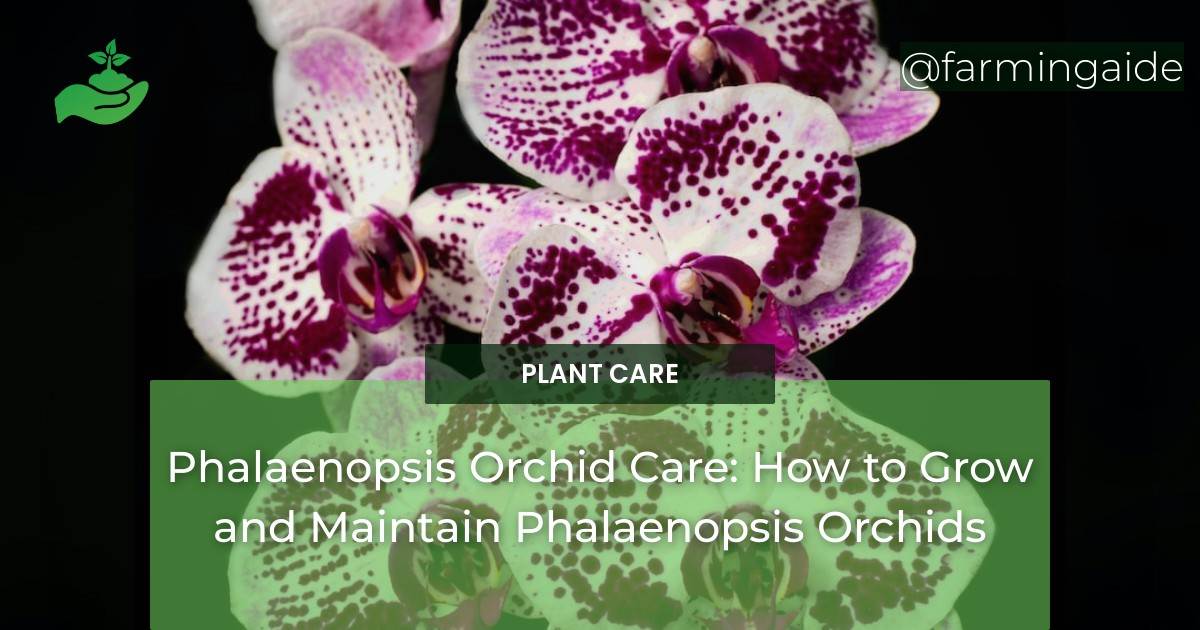Phalaenopsis orchids, also known as moth orchids, are beloved for their elegant and exotic blooms. These stunning plants are relatively easy to grow and maintain, making them a popular choice for both experienced and novice gardeners alike. In this comprehensive guide, we will walk you through all the essential aspects of Phalaenopsis orchid care, from light and temperature preferences to watering and fertilizing techniques, common pests and diseases, repotting and root care, and tips for encouraging reblooming. Whether you’re a seasoned orchid enthusiast or just starting your journey into plant care, this article will provide you with all the information you need to successfully grow and maintain healthy Phalaenopsis orchids.
Light and Temperature Preferences for Phalaenopsis Orchids
Ideal Light Conditions for Phalaenopsis Orchids
Phalaenopsis orchids thrive in bright indirect light, simulating their natural habitat in the tropical rainforests of Southeast Asia. Place your orchid near a window with filtered sunlight, but avoid exposing it to direct sunlight, as this can burn the delicate leaves and flowers.
Optimal Temperature Range for Phalaenopsis Orchids
Phalaenopsis orchids prefer moderate temperatures, ranging from 70°F to 80°F (21°C to 27°C) during the day and slightly cooler temperatures of 60°F to 70°F (15°C to 21°C) at night. It’s important to maintain consistent temperatures to ensure healthy growth and prevent stress to the plants.
Watering and Humidity Requirements for Healthy Phalaenopsis Orchids
Watering Phalaenopsis Orchids
Proper watering is crucial for the health of Phalaenopsis orchids. They prefer a moderate level of moisture, allowing the roots to dry slightly between waterings. Overwatering can lead to root rot, while underwatering can cause dehydration. To determine when to water, check the moisture level of the potting mix with your finger.
Humidity Needs for Phalaenopsis Orchids
Phalaenopsis orchids thrive in humid environments, similar to their native rainforest habitats. Aim to maintain humidity levels between 50% and 70%. You can increase humidity by placing a tray of water near the orchids or using a humidifier.
ALSO READ
Fertilizing and Feeding Phalaenopsis Orchids
Choosing the Right Fertilizer for Phalaenopsis Orchids
Phalaenopsis orchids benefit from a balanced orchid fertilizer that provides essential nutrients for healthy growth and blooming. Look for a fertilizer specifically formulated for orchids with a ratio such as 20-20-20 or 30-10-10. Avoid using standard houseplant fertilizers, as they may be too strong for orchids.
Feeding Techniques for Phalaenopsis Orchids
Fertilize your Phalaenopsis orchids every two weeks during the growing season, typically from spring to fall. Dilute the fertilizer according to the package instructions and apply it to the potting mix, taking care to avoid direct contact with the leaves or flowers. Adjust the fertilizing schedule during the dormant period.
Common Pests and Diseases Affecting Phalaenopsis Orchids and Their Control
Common Pests for Phalaenopsis Orchids
Phalaenopsis orchids are vulnerable to several common pests, including aphids, mealybugs, and scale insects. These tiny insects can cause damage to the leaves, flowers, and roots of the plants if left untreated.
Common Diseases for Phalaenopsis Orchids
Phalaenopsis orchids can be susceptible to various diseases, such as root rot, botrytis blight, and leaf spot. These diseases can weaken the orchids and lead to poor growth or even death if not addressed promptly.
Effective Control Measures for Pests and Diseases
For natural pest control, you can use organic remedies such as neem oil or insecticidal soap. Chemical treatments may also be necessary in severe infestations or disease outbreaks. Be sure to follow the instructions on the product labels and take precautions to protect yourself and the environment.
ALSO READ
Repotting and Root Care for Phalaenopsis Orchids
Knowing When to Repot Phalaenopsis Orchids
Phalaenopsis orchids generally require repotting every one to two years to provide fresh growing medium and prevent overcrowding of the roots. Signs that your orchid needs repotting include overcrowded roots spilling over the edges of the pot or when the potting mix breaks down and no longer drains properly.
Proper Repotting Techniques for Phalaenopsis Orchids
When repotting, choose a well-draining potting mix specifically designed for orchids, such as a blend of bark, sphagnum moss, and perlite. Carefully remove the orchid from its old pot, trim any damaged or dead roots, and place it in the new pot, ensuring the roots are spread out evenly. Avoid burying the orchid too deep.
Root Care Tips for Phalaenopsis Orchids
To maintain healthy roots, avoid overwatering your Phalaenopsis orchids. Ensure proper drainage by using a well-draining potting mix and pot with ample drainage holes. Regularly inspect the roots for signs of rot or disease, such as soft or discolored roots. Trim any affected roots to prevent the spread of infection.
What Are the Best Tips for Growing and Maintaining Phalaenopsis Orchids?
When it comes to growing and maintaining Phalaenopsis orchids, there are several fascinating types and growing tips to keep in mind. These beautiful flowers thrive in indirect light and require regular watering. It’s important to repot them every 1-2 years and provide proper ventilation to prevent root rot.
Tips for Reblooming Phalaenopsis Orchids
Providing Optimal Conditions for Reblooming
To encourage your Phalaenopsis orchids to rebloom, you need to provide them with optimal conditions. Adjust the temperature and light levels to simulate the changing seasons and trigger the plants to enter a rest period, which is essential for the formation of new flower spikes.
Pruning and Stimulating Reblooming
After your orchid has finished blooming, trim the old flower stems close to the base to redirect energy to new growth. To stimulate the development of new shoots and buds, apply a balanced orchid fertilizer and maintain consistent care, including proper watering and fertilization.
By following these comprehensive guidelines for Phalaenopsis orchid care, you can enjoy the beauty of these graceful plants and help them thrive in your home or garden. Remember to observe and adjust your care routine based on the specific needs of your orchids, as individual plants may require slight variations in care. Now, let’s embark on this rewarding journey of growing and maintaining Phalaenopsis orchids!


